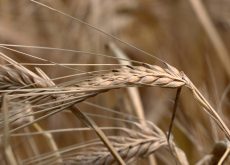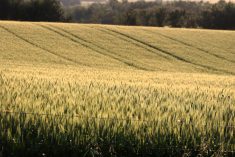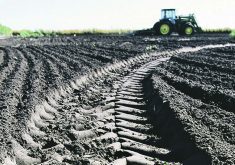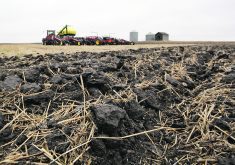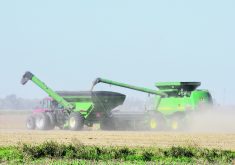Recent Sask. study suggests benefits from lower wheat seeding rates for low moisture, but that might not transfer to Man.
Recent research from Saskatchewan suggests farmers might want to hold back on their wheat seeding rate if they’re expecting a dry year, but it’s not clear how well the insight translates to Manitoba.
The Western Applied Research Corporation study found that with a dry season on the horizon, a mid-to-low wheat seeding rate achieved the best yield. If the moisture outlook is good, farmers can go with a higher seeding rate.
Spring has sprung and wheat tops the seeding agenda for many grain operations.
Read Also

Phosphate prices to remain high
Phosphate prices are expected to remain elevated, according to Mosaic’s president.
That project, launched in 2022, was in response to the cycle of drier growing seasons that has gripped the Prairies, WARC research manager Jessica Enns said.
“Some producers were asking if the standard provincial recommendation for wheat seeding rates should be adjusted due to the dry weather.”
The project kicked off at two sites in the first year, expanding in 2023 to eight sites in Saskatchewan, including Prince Albert, Melfort, Yorkton, Indian Head, Swift Current and Scott. Seven seeding rates were tested at all sites, ranging from 10 to 40 plants per sq. foot.
Results found that optimum wheat yields at sites with lower moisture emerged with a target plant count between 15 and 25 plants per sq. foot, for an average density of 20. When moisture jumped, that ideal target shifted to 25 to 35 plants per sq. foot, or an average of 30.
“Those sites where the growing season moisture was below 70 per cent of the long-term average were described as the low-moisture group, while sites with moisture greater than 70 per cent of the long-term average were placed in the high-moisture group,” Enns said.
Hard red spring wheat varieties planted on each site were selected according to the popular varieties in that region. At Scott and Indian Head, they seeded AAC Wheatland; at Melfort it was AAC Starbuck; at Prince Albert, AAC Brandon went in the ground; at Swift Current it was CDC Adamant VB and at Yorkton, AAC Alida VB was the variety of choice.
To determine the performance of each wheat plot, they measured yield, head density, tillering, head size and length.
Optimum-yielding plots in low-moisture conditions had an average of 55 seed heads per sq. foot and between one and two tillers per plant. At high-moisture sites, the ideal density plots produced between one and two tillers and had both the highest head densities and the highest yields.
Researchers found that in both low- and high-moisture groups, a seeding rate that produced between one and two tillers per plant was optimum. In plots with more tillering, competition led to lower yields.
In a perhaps unsurprising result, they also found that greater yields translated to lower protein on all sites.
“We don’t have a specific moisture number, but these results suggest if conditions are dry at seeding and it appears to be a dry growing season ahead, opt for the lower plant count,” Enns said.
Manitoba Agriculture cereal specialist Anne Kirk said that, while they’ve done similar seeding rate trials in Manitoba, they didn’t split the sites into high- and low-moisture locations. It’s impossible to say if results would be the same as they were in Saskatchewan.
“Based on our research in Manitoba, we found that wheat yielded similarly across a range of plant stands, so if yields ended up being low, then it would have been more economical to seed at a lower seeding rate,” Kirk said.
High plant stands did not correlate with reduced yields, although Kirk noted that might be because those trials had adequate moisture.
Recent surveys have shown that Manitoba farmers tend to use higher seeding rates than the other Prairie provinces. Kirk said researchers’ best guess is that the province’s typically higher moisture potential supports that practice. It may also be because Manitoban farmers are targeting uniform plant stands and tillering for fungicide application.
Manitoba Agriculture recommends targeting a plant stand of 23 to 28 plants per sq. foot. Kirk said she suggests aiming for the higher end of that.
Some producers will seed for an even higher plant stand, Kirk added. However, plot trials haven’t supported that.
“We haven’t found a justification to really increase those seeding rates past that 28 to 30 plants per sq. foot.”
Seedbed moisture is adequate at present, so Kirk said she sees no reason to not stick to status quo seeding rates.
Despite the Saskatchewan research, Kirk argues that under lower-yield potential scenarios, seeding rates should be increased because the wheat will be less efficient at using resources. Under high-yield potential scenarios, farmers can get away with slightly reducing seeding rates.





